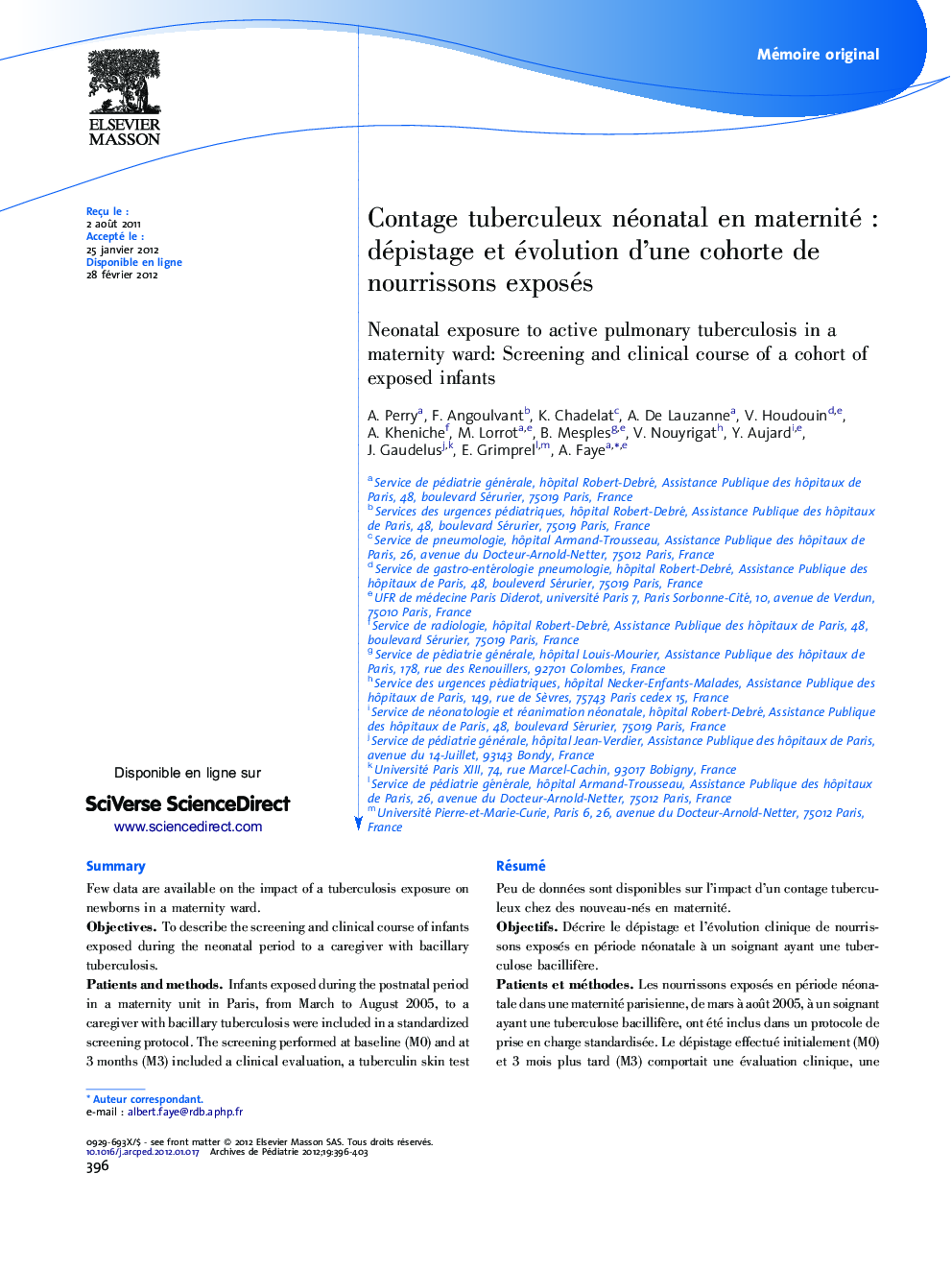| کد مقاله | کد نشریه | سال انتشار | مقاله انگلیسی | نسخه تمام متن |
|---|---|---|---|---|
| 4147354 | 1272671 | 2012 | 8 صفحه PDF | دانلود رایگان |

RésuméPeu de données sont disponibles sur l’impact d’un contage tuberculeux chez des nouveau-nés en maternité.ObjectifsDécrire le dépistage et l’évolution clinique de nourrissons exposés en période néonatale à un soignant ayant une tuberculose bacillifère.Patients et méthodesLes nourrissons exposés en période néonatale dans une maternité parisienne, de mars à août 2005, à un soignant ayant une tuberculose bacillifère, ont été inclus dans un protocole de prise en charge standardisée. Le dépistage effectué initialement (M0) et 3 mois plus tard (M3) comportait une évaluation clinique, une intradermoréaction à la tuberculine (IDR) et une radiographie de thorax. Un traitement antituberculeux préventif par isoniazide et rifampicine pendant 3 mois a été systématiquement proposé.RésultatsÀ M0, 182 nourrissons sur 217 (84 %) ayant pu être exposés ont été dépistés. Cent soixante-douze dossiers ont pu être analysés. À M0, l’âge médian était de 4,9 mois (intervalle interquartile [IQR] = 3,8–6,2) et 4 nourrissons sur 172 (2,3 %) avaient une infection tuberculeuse latente. Entre M0 et M3, 19 nourrissons (11 %) ont été perdus de vue et 1 nourrisson a développé une infection tuberculeuse latente. Au total, 5 nourrissons sur 172, soit 2,9 %, avaient une infection tuberculeuse latente. Aucun cas de tuberculose maladie n’a été diagnostiqué. Le traitement a été correctement administré dans 83 % des cas ; des effets secondaires ont été observés chez 11 % des nourrissons, mais aucun effet secondaire grave n’a été rapporté. Quatre nourrissons n’ont pas reçu de traitement et 11 autres l’ont arrêté prématurément.ConclusionEn l’absence de contage néonatal massif, le risque d’infection tuberculeuse latente, bien que faible (2,9 %), nécessite une surveillance rapprochée des nourrissons exposés. Toutefois, dans un contexte de contage ponctuel en maternité, une surveillance sans prescription systématique d’un traitement antituberculeux préventif pourrait être discutée.
SummaryFew data are available on the impact of a tuberculosis exposure on newborns in a maternity ward.ObjectivesTo describe the screening and clinical course of infants exposed during the neonatal period to a caregiver with bacillary tuberculosis.Patients and methodsInfants exposed during the postnatal period in a maternity unit in Paris, from March to August 2005, to a caregiver with bacillary tuberculosis were included in a standardized screening protocol. The screening performed at baseline (M0) and at 3 months (M3) included a clinical evaluation, a tuberculin skin test (TST), and a chest X-ray. A preventive treatment for tuberculosis with isoniazid and rifampicin for 3 months was systematically proposed.ResultsAt M0, 182 of the 217 infants (84%) with significant exposure were evaluated. Data were available for 172 infants. The median age at M0 was 4.9 months (IQR = 3.8–6.2). At M0, 4 of 172 infants (2.3%) had latent TB infection. Between M0 and M3, 19 infants (11%) were lost to follow-up and 1 on 153 developed a latent TB infection. No cases of tuberculosis disease were diagnosed. The treatment was administered properly in 83% of cases and side effects were observed in 11% of infants without any serious adverse event. Four infants received no treatment and 11 stopped their treatment prematurely.ConclusionIn the absence of neonatal massive exposure, although low (2.9%), the risk of latent TB infection requires close monitoring of the infants exposed. However, in the context of a mild exposure in the maternity unit, surveillance without systematic initiation of TB preventive treatment could be discussed.
Journal: Archives de Pédiatrie - Volume 19, Issue 4, April 2012, Pages 396–403